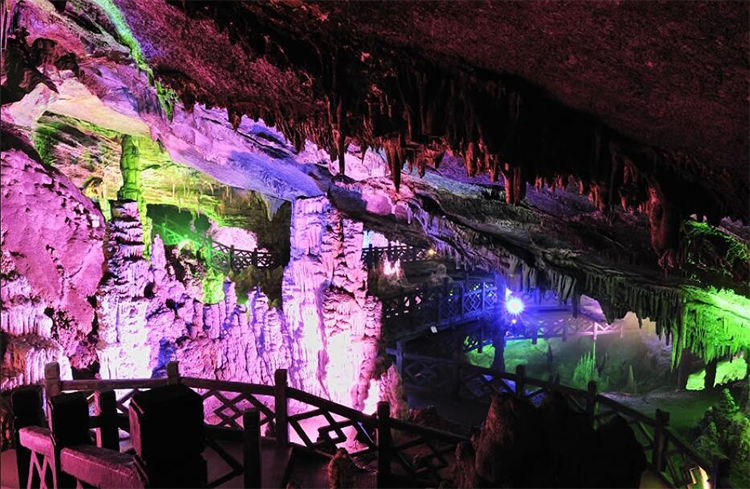Qixi Festival Guide: Fenyi Karst Caves — China’s Romantic ‘Cave of Love’
Introduction:
When stalactites form a Milky Way bridge and an underground river seems to murmur the weaver girl’s name, Fenyi’s karst caves retell love stories written in stone over hundreds of millions of years. Tucked into the hills of Fenyi, Jiangxi, this 4A scenic area is both a natural karst museum and a three-dimensional love letter of light, shadow, and myth. Lace up comfortable walking shoes, bring curiosity, and prepare to step into more than a cave—enter an Eastern romance preserved by Earth’s movements for millennia.
1. Cave Wonders: when geology meets romance
Known as “China’s first cave cluster themed around marriage and romance,” the Niulang-Zhinv Cave stretches 1,600 meters like a scroll crumpled by immortals. Every fold hides a surprise: a 20-meter stone waterfall is said to be the spilled elixir of the Queen Mother, terraced rimstone pools serve as bathing steps for fairies, and stalactites and stalagmites descend and rise toward each other at about 1 centimeter per century. Geologists say they still need some 800 years before they finally meet—perhaps the longest love wait on Earth.
Step into the Divine Ox Cave and kneel close to the polished rock. Press your ear to certain walls and you’ll hear the distant roar of an underground river—the famed “listen-to-the-earth” phenomenon. Guides love to wink: “The Divine Ox carries Niulang’s longing to Zhinv beneath the stone.”
2. Cultural decoding: a holographic Qixi celebration
Here, Qixi culture is not a museum exhibit but a living, touchable experience. Inside the Marriage Palace, holograms bring a hanfu-clad bride to life from carved stone to demonstrate the traditional Three Documents and Six Rites. At the Magpie Bridge Theater, AR magpies will even carry your phone photo across a virtual Milky Way—creating a personalized digital postcard to keep.
Visit on the seventh day of the seventh lunar month for a highly authentic revival of the ancient Qiqiao ritual. Try threading colorful silk through nine-holed needles or carving fruits into birds and flowers—Song dynasty women’s festival traditions recorded in Dongjing Menghua Lu that now feel fresh again with modern tech.

3. Nature’s gift: the eternal 18°C spring
Even when Jiangxi summers soar above 35°C, the cave remains refreshingly cool—typically around 18–22°C year-round. In winter, the contrast is striking: freezing winds outside, springlike warmth inside thanks to geothermal balance. Guides will point out the “breathing rocks”—mineral-rich walls that subtly change color with humidity, like nature’s own mood ring.
The surrounding area is a natural oxygen bar with roughly 85% forest cover; rare birds such as white eared pheasants and red-bellied tragopans often streak across the canopy. If you visit after the rainy season, the exterior transforms into a maze of seasonal waterfalls and curtains of water.
4. Practical guide: start your time-travel journey
– Transportation: Drive from Nanchang Changbei Airport via the Daguang Expressway in about two hours, or take high-speed rail to Xinyu North Station and transfer to the daily tourist shuttle (three departures; 40-minute ride). The scenic area parking lot includes EV charging stations.
– Recommended routes:
– Highlights (3 hours): Visitor Center → Divine Ox Cave → Time Tunnel → Niulang-Zhinv Cave → Marriage Palace
– Deep Dive (5 hours): add forest trails and an intangible heritage workshop to learn summer cloth double-knot craft
– Ticket tips: Buy tickets on the official mini-program one day ahead for a 10% discount. Couples’ tickets include a carved “together-lock” experience. Visitors aged 60+ enter free with ID but must purchase a ¥20 eco-shuttle ticket.

5. Hidden must-see: the starry ceiling
In the third chamber of Niulang-Zhinv Cave look up for the “starry ceiling”—over 7,000 natural fluorite nodules that emit a faint blue-green glow when lights are dimmed, creating a miniature Milky Way. Photographers: bring a tripod and try long exposures to capture what feels like an underground aurora.
Conclusion:
Fenyi’s Cave of Love is a crystal polished by time: it reflects a 280-million-year-old seabed world and the modern imagination of eternal love. Touching a still-growing stalactite, you may realize that the most beautiful scenes aren’t just forms before your eyes but the romance written where nature and culture meet. Now is the time to come and write your own chapter.


